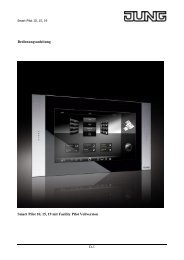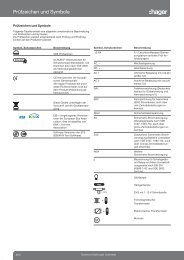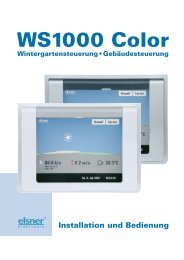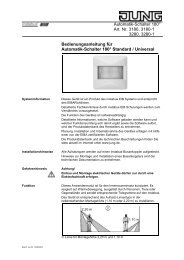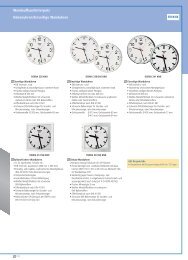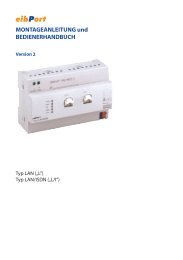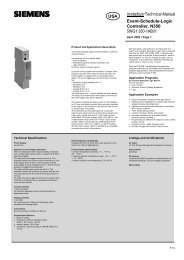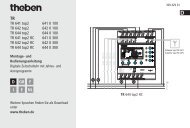You also want an ePaper? Increase the reach of your titles
YUMPU automatically turns print PDFs into web optimized ePapers that Google loves.
- "IP" tab<br />
The IP communication parameters for the Ethernet connection are defined here. It is important<br />
to make exactly the same settings here as are stored in the panel. The "IP address"<br />
and the "Ports" used must therefore agree with the values of the same name in the panel.<br />
The valid IP settings of the panel can be viewed on the device on the service page under<br />
"Area 3 -> IP settings" and applied in exactly the same way.<br />
When DHCP is used for automatic address allocation in the network, it should be noted<br />
that the DHCP Server always assigns different IP addresses to the panel on a initialisation<br />
operation after a device reset, which must then be applied to the connection settings. If,<br />
during system operation, device resets are common, e.g. due to power supply disconnections,<br />
then static IP addresses should be used.<br />
The communication connection between the PC Client software and the panel is protected<br />
by a password to avoid unauthorised access to the device. With the PC Client software, the<br />
device password is set on the "IP" tab. The password entered in the PC Client software<br />
and the panel must be identical. The password for the panel is configured in the top parameter<br />
node of the "General" parameter group.<br />
The device password may be a maximum of 16 characters in length. The box can also be<br />
left empty in the PC Client software and in the ETS plug-in, meaning that communication<br />
between the PC Client software and the panel takes place without password protection.<br />
The password is indicated in the input box by "*" and encrypted in the communication connection.<br />
This means that it is safe from sabotage.<br />
- "Datalogger" tab<br />
The PC Client software can also read out the recorded data values of the datalogger. This<br />
allows simple recording of, for example, counter values or other consumption data and<br />
archiving in a CSV file format. When the data is loaded from the device, the PC Client software<br />
saves the CSV files of each datalogger channel to a target folder. This save location<br />
can be edited on the "Datalogger" tab.<br />
The CSV is clearly indicated in the filename. This makes the datalogger channel number<br />
and the date and time clear in the name. The date and time are derived from the data value<br />
of the last time interval of the appropriate datalogger channel. A prefix can be optionally added<br />
to the filename. In this way, the device name can, for example, be applied to the filename,<br />
allowing clear identification of the source of the datalogger data.<br />
i If the PC Client software is unable to create a remote or configuration connection to the<br />
panel due to incorrect device connection settings, then an error message is displayed. In<br />
this case, the IP connection settings (IP address, ports) are compare with the valid values<br />
of the panel. This must especially be complied with in the case of DHCP-administered networks.<br />
Data exchange, reading out the datalogger<br />
The PC Client software can also read out the recorded data values of the datalogger. This allows<br />
simple recording of, for example, counter values or other consumption data and archiving<br />
in a CSV file format. When the data is loaded from the device, the PC Client software saves the<br />
CSV files of each datalogger channel to a target folder, defined in the device connection settings.<br />
Reading out of the datalogger can be started in the "Settings" menu by opening the menu item<br />
"Load datalogger data from the device...". The PC Client software then sets up an IP connection<br />
to the panel, reads out the data values and saves them to a CSV file. The successfully read-out<br />
datalogger channels and the filenames and save locations are displayed to the end user in a<br />
separate message window. Then, the saved files can be opened and viewed and processed in<br />
a suitable table calculation.<br />
Order-No. 7574 00 1X<br />
PC Client software<br />
Connection settings, data exchange and device update<br />
Page 207 of 222




